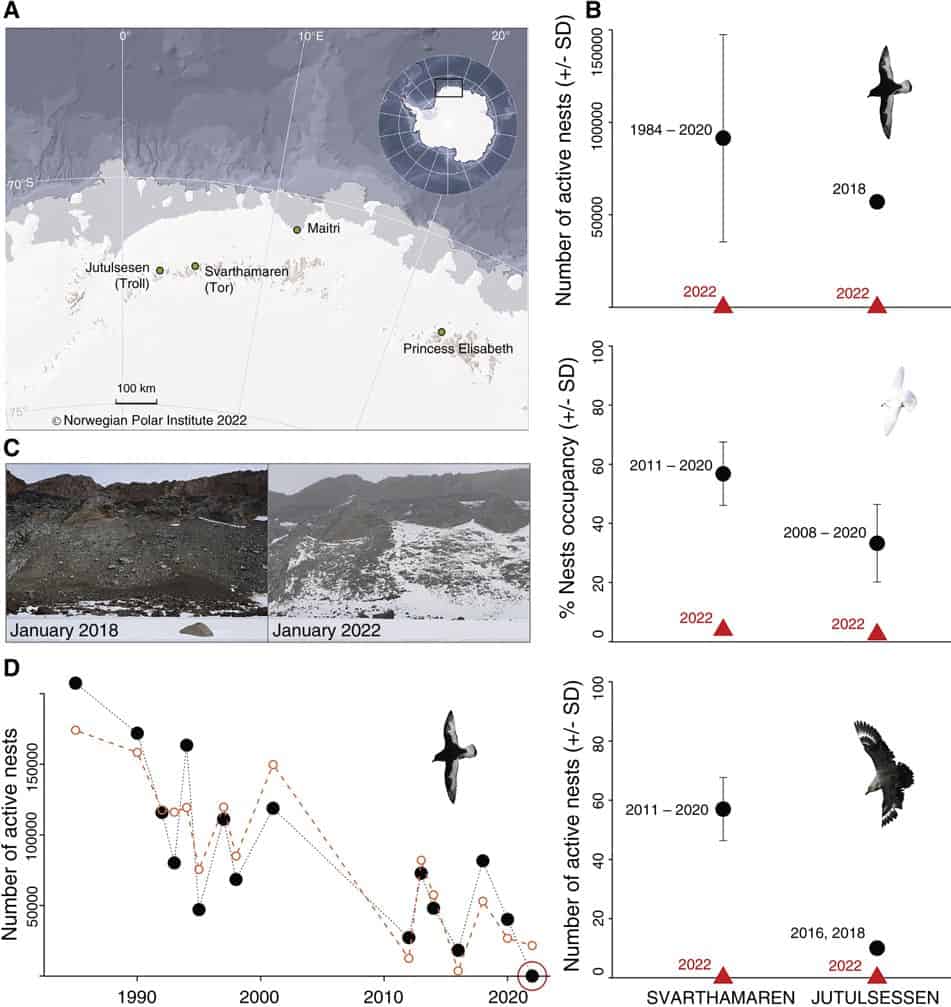The onset of a new year is a crucial season for the avian population residing in Antarctica, particularly for species like the south polar skua, Antarctic petrel, and snow petrel, who utilize this period to construct their nests and lay eggs.
Regrettably, the latest report from researchers studying the birdlife in the Svarthamaren region from December 2021 to January 2022 is disconcerting. Despite extensive monitoring efforts, not a single skua nest was found in the area, indicating an alarming decline in their reproductive activities.
Moreover, the count of nests belonging to the Antarctic petrel and snow petrel has plummeted drastically, hovering close to zero. This new development is undoubtedly concerning, as these birds are critical to the Antarctic ecosystem and their dwindling population could have far-reaching ecological implications.
New research published today in the journal Current Biology has shed light on the adverse impact of climate change on the breeding patterns of avian species in certain regions. The study indicates that increased snowfall and snow accumulation, caused by climate change, have significantly affected the breeding activities of birds.
“We know that in a seabird colony, when there’s a storm, you will lose some chicks and eggs, and breeding success will be lower,” adds first author Sebastien Descamps. “But here we’re talking about tens if not hundreds of thousands of birds, and none of them reproduced throughout these storms. Having zero breeding success is really unexpected.”
Svarthamaren and Jutulsessen, two crucial breeding grounds for a variety of Antarctic birds, have long been home to some of the largest colonies of Antarctic petrels in the world. The region has also been a vital nesting spot for snow petrels and south polar skuas for several decades.

Historical data from 1985 to 2020 reveals that the Svarthamaren colony contained between 20,000 to 200,000 Antarctic petrel nests, approximately 2,000 snow petrel nests, and over 100 skua nests annually. However, in the 2021-2022 breeding season, there was a significant drop in the number of breeding birds, with only three breeding Antarctic petrels, a few snow petrels, and no skua nests observed in the area.
Similarly, in Jutulsessen, which has previously hosted tens of thousands of active Antarctic petrel nests during the summer months, the breeding population in the 2021-2022 season was almost non-existent, with no active nests found in the area.
“It wasn’t only a single isolated colony that was impacted by this extreme weather. We’re talking about colonies spread over hundreds of kilometers,” adds Descamps. “So these stormy conditions impacted a really large part of land, meaning that the breeding success of a large part of the Antarctic petrel population was impacted.”
The breeding habits of these birds are such that they lay their eggs on bare ground, making it impossible for them to breed when the ground is covered with snow. The intense snowstorms in recent times have made it increasingly challenging for the birds to access the ground, thereby making it difficult for them to raise their young.
Furthermore, these storms pose a significant thermoregulatory challenge for the birds, as they must expend a significant amount of energy to keep warm and conserve their strength. This situation is particularly critical for the breeding pairs as they need to maintain their physical strength to care for their young.
“Until recently, there were no obvious signs of climate warming in Antarctica except for on the peninsula,” remarks Descamps. “But in the last few years, there have been new studies and new extreme weather events that started to turn the way we see climate change in Antarctica.”
Descamps expects that the storm severity prediction model may be improved over time to become even more precise.
“When it comes to storm severity, it’s both the wind and the snow accumulation,” he adds. “There aren’t many places where we have the right kinds of snow measurements, and it plays an important role in explaining the breeding success of the birds.”
“I think our study shows in a very strong way that these extreme events do have a very strong impact on seabird populations, and climate models predict that the severity of these extreme events will increase,” adds Descamps.
Source: 10.1016/j.cub.2022.12.055
Image Credit: Wolfgang Kaehler/LightRocket via Getty Images
